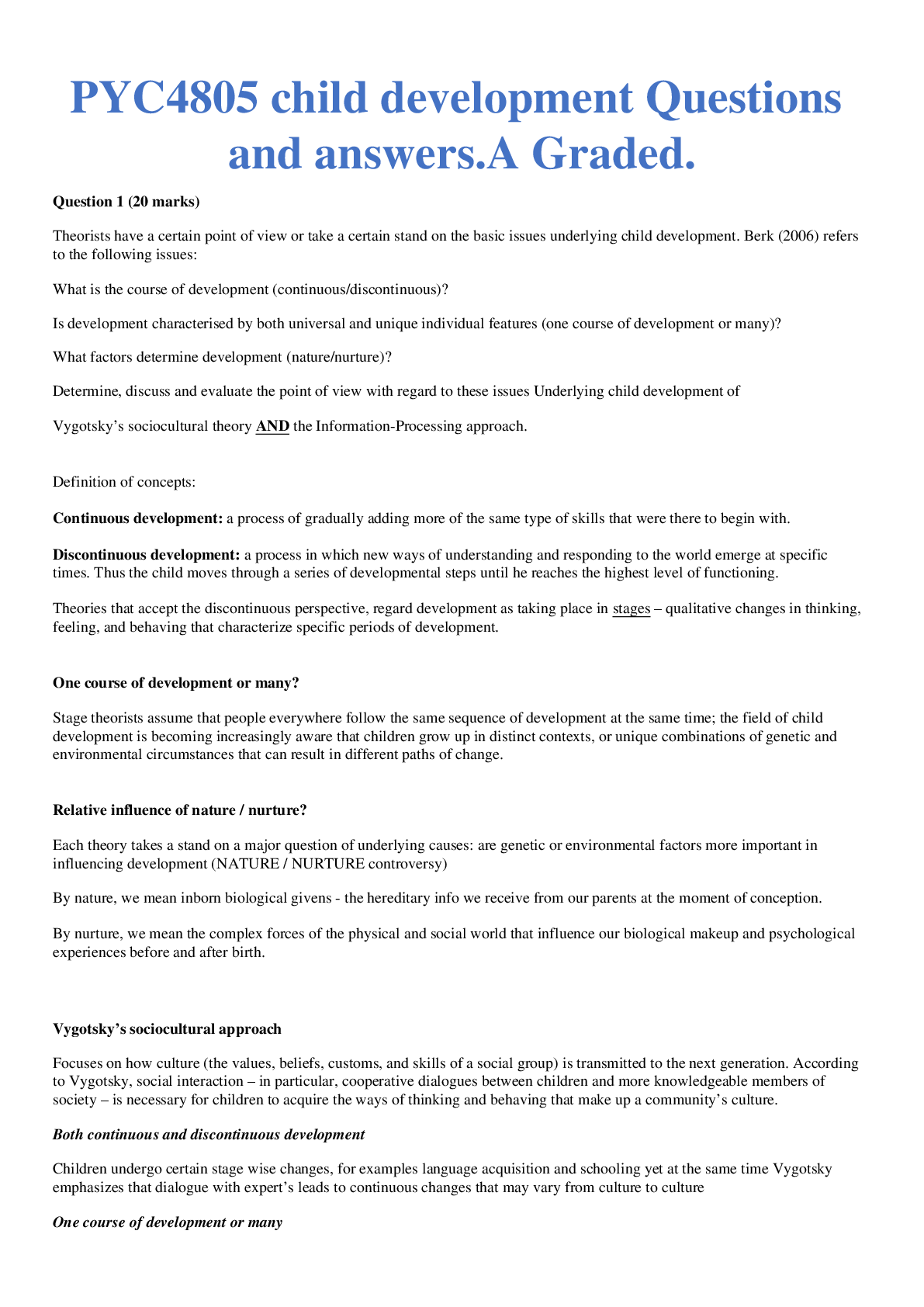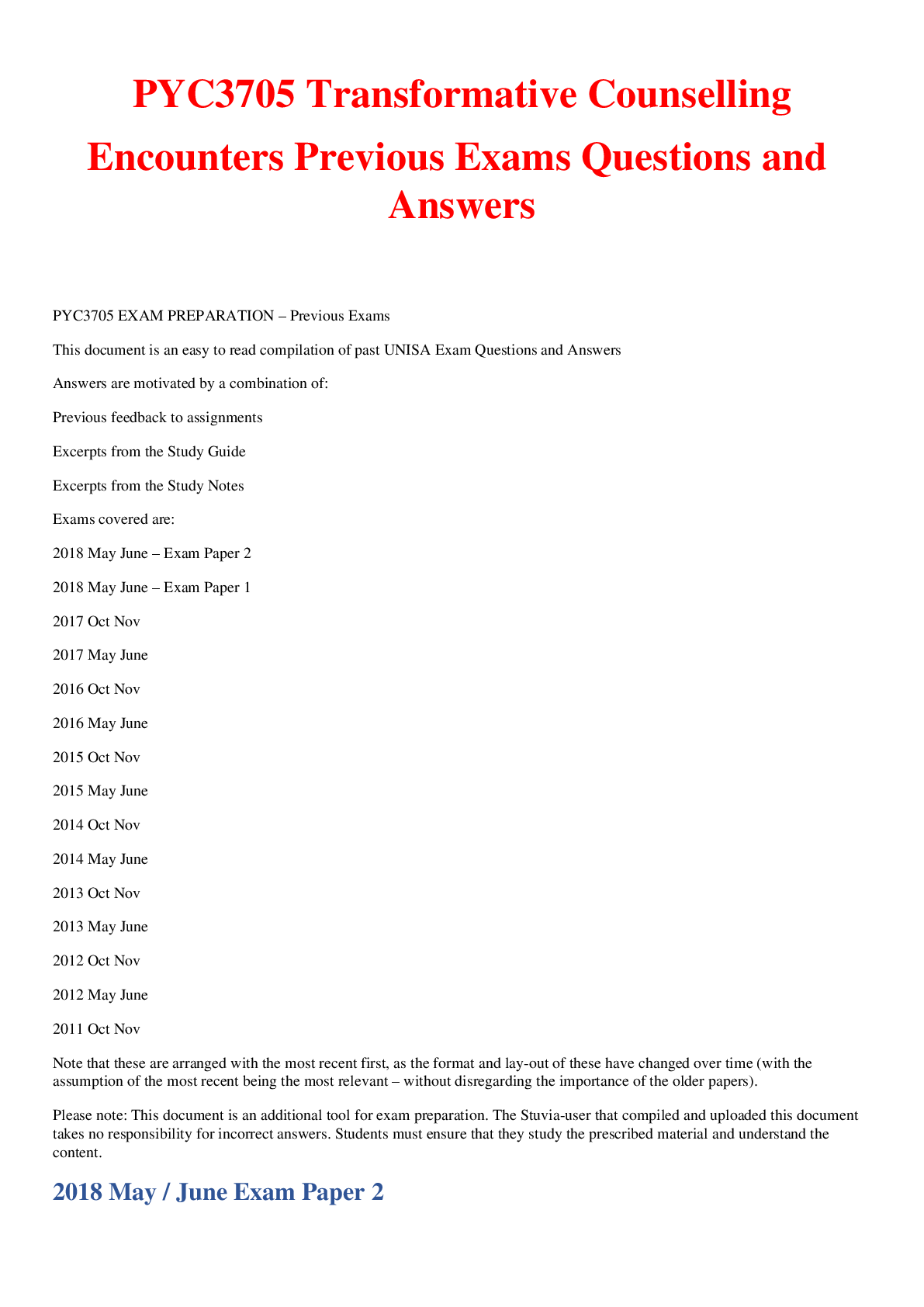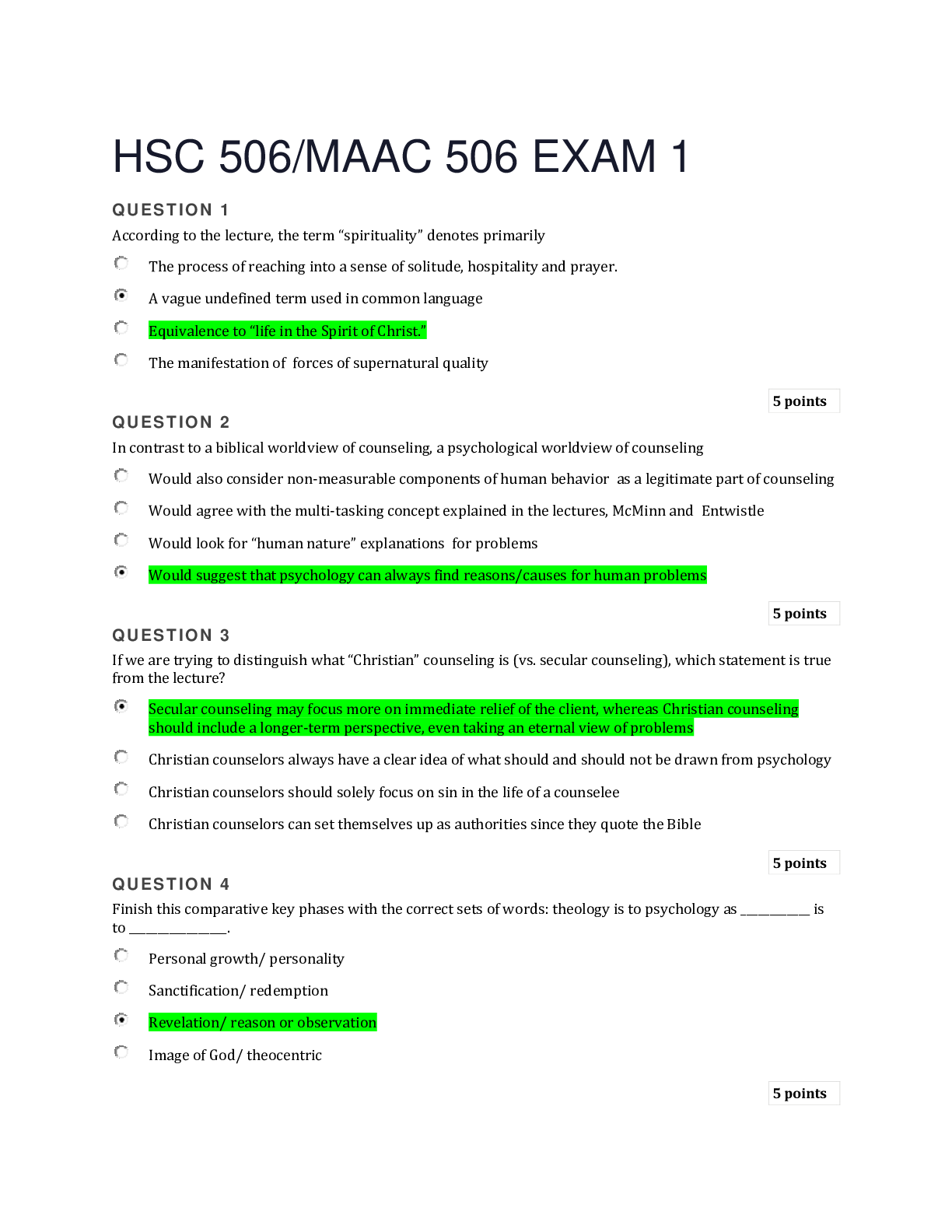*NURSING > EXAM REVIEW > 615 Pharm-Nurs 615 Pharm Exam 4 Review | Questions and Answer solutions | Already Graded A. (All)
615 Pharm-Nurs 615 Pharm Exam 4 Review | Questions and Answer solutions | Already Graded A.
Document Content and Description Below
Week Twelve 1. What is tiotropium used to treat? (Spiriva) Tiotropium bromide (INN) is a long-acting, 24-hour, anticholinergic bronchodilator used in the management of chronic obstructive pulmonar... y disease (COPD). Tiotropium is used for maintenance treatment of chronic obstructive pulmonary disease (COPD) which includes chronic bronchitis and emphysema. It is not however used for acute exacerbations. Tiotropium is a muscarinic receptor antagonist, often referred to as an antimuscarinic or anticholinergic agent. Although it does not display selectivity for specific muscarinic receptors, when topically applied it acts mainly on M3 muscarinic receptors[8] located on smooth muscle cells and submucosal glands. This leads to a reduction in smooth muscle contraction and mucus secretion and thus produces a bronchodilatory effect. 2. What are the adverse effects with montelukast (Singular)? Side effects of Singulair can include skin rash, mood changes, tremors, headache, stomach pain, heartburn, upset stomach, nausea, diarrhea, tooth pain, tiredness, fever, stuffy nose, sore throat, cough, and hoarseness. Singulair may interact with phenobarbital or rifampin 3. What patient teaching should accompany the prescription of montelukast (Singulair)? Singulair will not work fast enough to treat an asthma attack that has already begun. Use only a fast-acting inhalation medicine to treat an asthma attack. Talk with your doctor if any of your asthma medications do not seem to work as well in treating or preventing attacks. Call your doctor right away if you feel that this medicine is not working as well as usual, or if it makes your condition worse. If it seems like you need to use more of any of your medications in a 24-hour period, talk with your doctor. If you already take Singulair to prevent asthma or allergy symptoms, do not use it for exercise- induced bronchoconstriction. Call your doctor at once if you have any mood or behavior changes, anxiety, depression, or thoughts about suicide or hurting yourself. Follow all directions on your medicine label and package. Tell each of your healthcare providers about all your medical conditions, allergies, and all medicines you use. It may take up to several weeks before your symptoms improve. Keep using Singulair as directed and tell your doctor if your symptoms do not improve after several weeks of treatment. 4. What patient teaching should be provided when prescribing inhaled corticosteroids? They should be taken 2x a day every day for the use of prevention of asthma. Rinse mouth after use to prevent oral thrush. 5. What ethnic background should not be prescribed long-acting beta agonists? African Americans, increased incidence of death in this population 6. What medication would you prescribe for bronchospasm for a patient taking propranolol? Ipratropium 7. What is the mechanism of action of albuterol? Relaxes bronchial smooth muscle by action on beta2-receptors with little effect on heart rate, causing dilation of the airways. 8. What is the mechanism of action of inhaled corticosteroids? Extremely potent vasoconstrictive and anti-inflammatory activity. 9. When is it appropriate to use a short acting beta agonist? Short-acting beta-2 agonists (SABAs) are the drug of choice for acute treatment of asthma symptoms and exacerbations. 10. What is the mechanism of action of inhaled muscarinic receptor antagonists? Atropine (the prototype of muscarinic receptor antagonists) prevents the effects of ACh by competitively blocking its binding to muscarinic receptors in the CNS, peripheral ganglia, and at neuroeffector sites on smooth muscle, cardiac muscle, and secretory glands. Atropine inhibits secretions of the nose, mouth, pharynx, and bronchi and thus causes dryness of the mucous membranes of the respiratory tract. This action is especially marked if secretion is excessive and is the basis for the use of atropine and scopolamine in preanesthetic medication. This depression of mucous secretion and the inhibition of mucociliary clearance, however, are undesirable side effects of atropine in patients with airway disease. Atropine is particularly effective against bronchoconstriction produced by Para sympathomimetic drugs such as methacholine; it also partially antagonizes bronchoconstriction induced by histamine and bradykinin. In general, however, muscarinic receptor antagonists cause little blockade of the effects of ACh at nicotinic receptor sites. As a result, extremely high doses of atropine or related drugs are required to produce any degree of blockade of the predominantly nicotinic receptors at the neuromuscular junction [2]. 11. What are the adverse effects associated with inhaled corticosteroids? Thrush, dysphonia, cough and bronchospasm, thin skin, bone loss, smell of burning plastic, HA, visual changes Week Thirteen 1. What special populations should not be prescribed pseudoephedrine? Not to be used in children under four years of age, elderly, and patients with HTN. 2. What drug should be prescribed for a patient with nasal congestion with hypertension? Coricidin HBP 3. What are the adverse effects of antihistamines? Drying effects: dry mouth, difficulty urinating, constipation, changes in vision, mild drowsiness to deep sleep, increased heart rate, motor-impairment, flushed skin, photosensitivity, itching skin, increased body temp, nausea or vomiting. 4. What conditions should cause a patient to avoid the use of antihistamines? Patients over 60 or under 6 years of age; elderly, Antihistamines are contraindicated for nursing mothers, newborns, and premature infants. Persons with certain medical conditions, or individuals taking certain medication should not take antihistamines. If you are suffering from thyroid disease, high blood pressure, heart disease, kidney disease, liver disease, asthma, chronic bronchitis, emphysema, difficult urination, or glaucoma you should talk to your doctor before taking an antihistamine. Individuals using medications like sedatives, sleeping pills, or muscle relaxants, should speak to their doctor before using an antihistamine. Before taking this or any other medication, you should talk to your doctor about all of the possible interactions you may experience. Men with BPH. 5. What is the mechanism of action of codeine in the suppression of cough? The physiological mechanism of cough is complex, and little is known about the specific mechanism of action of the opioid antitussive drugs. The receptors involved appear to be different than those involved with the other actions of opioids. It is likely that both central & peripheral effects may play a role. It works as a CNS depressant. Works on the cough center of the brain in the medulla oblongata. 6. Which medications are considered antitussives? Dextromethorphan; Codeine; Benzonatate; ( examples include: Scot-Tussen DM; Hold DM; Robitussion; Vicks; Delsym; and generic) 7. How are upper respiratory infections treated? URIs are mostly treated for relief of symptoms. Some people benefit from the use of cough suppressants, expectorants, vitamin C, and zinc to reduce symptoms or shorten the duration. Other treatments include: • Nasal decongestants can improve breathing. But the treatment may be less effective with repeated use and can cause rebound nasal congestion. • Steam inhalation and gargling with salt water are a safe way to get relief from URI symptoms. • Analgesics like acetaminophen and NSAIDs can help reduce fever, aches and pains. Week Fourteen 1. What patient education should be provided to the patient taking antacids? May cause constipation or diarrhea. 2. What is the action of loperamide? Slows gastric motility and diminishes the loss of fluid and electrolytes. 3. What are the adverse effects of bismuth subsalicylate? It can cause rebound constipation; gray/black stools and black tongue (does not indicate GI bleeding). 4. What special population should not be administered bismuth subsalicylate? Children and adolescents should not be administered this during or after recovery from chickenpox or flu-like illness. Also, not for anyone with aspirin hypersensitivity. 5. When should bismuth subsalicylate be administered? It is indicated in the use of Traveler’s Diarrhea due to its antibacterial and antisecretory properties. Before each meal and at bedtime for up to 4 times a day for up to 3 weeks. It should be administered after each loose stool up to the maximum daily dose. Also as part of the tx for H. pylori to reduce the chance of ulcers. 6. What lab values should be monitored with long-term administration of proton pump inhibitors? LFTs; H&H; Vit B12; Ca++; bone-density monitoring for pts with osteoporosis. Assess for B12 deficiency and calcium deficiency. The patient is at risk for developing megablastic anemia. The patient is also at risk for developing hip fractures and osteoporosis. 7. Why is osteoporosis a risk when taking omeprazole? It's not clear how PPIs might increase fracture risk, but it may be that by inhibiting stomach acid, PPIs speed up bone mineral loss. Bone fractures due to lose of calcium. 8. What is the most rapid acting laxative and why? Stimulants due to the direct action on intestinal mucosa by stimulating the mesenteric plexus. Facilitate the release of prostaglandins and increase cAMP concentration, thus increase electrolyte concentration and stimulates peristalsis. (pg. 534) Rectal admin of Bisacodyl laxative is the most rapid action. 9. How does metoclopramide improve GERD? It increases tone and amplitude of gastric contractions & relaxes the pyloric sphincter & duodenal bulb, & increases peristalsis of the duodenum and jejunum resulting in accelerated gastric emptying and increase speed of gastric transit. Works on the dopamine receptors. 10. What is the Step Down Approach with GERD? Start with lifestyle modifications and PPI for 8 weeks. If symptom free for 4 weeks, step down to H2RA. If symptoms not relieved, increase PPI to BID for 4-8 weeks. If symptom free for 4 weeks, step down to daily PPI and reassess in 6-12 mos. If symptoms not relieved refer patient out for an endoscopy. 11. What is the Step Up Approach with GERD? 1-antacids, lifestyle & OTC antacids H2 RAs and -PPI (if no erosive disease present) 4-8 weeks if better- back to H2, if worse continue if not better- refer out 12. What is the first line therapy for peptic ulcer disease with a positive H. pylorus? PPI 2x daily, amoxicillin 1g 2x daily, and clarithromycin 500mg 2x daily for 7 to 14 days. Triple line therapy and continue PPI for 8 to 12 weeks until healing is completed. Second line therapy for those you fail treatment initially: PPI 2x daily, metronidazole, tetracycline, and bismuth salicylate for 14 days. Quadruple therapy. Treatment may fail due to microbial resistance. 13. How will you treat nausea and vomiting? First-line therapy is vitamin B6 and Unisom, especially in pregnant women. Ginger is helpful. Zofran, especially in children 14. How will you treat constipation in children? Miralax is first line treatment. Bulk form laxatives are the safest and produces physiologic effect similar to increasing fiber in the diet. Bulk forming are used for management of chronic diarrhea in adults. Lactulose can be administered to children if bulk is ineffective. Dose is 7.5mL qd 15. What are the disadvantages of using stimulant laxatives for prolonged periods of time? Long-term use of stimulant laxatives can lead to loss of colon function (cathartic colon). After years to decades of frequent use of stimulant laxatives, the nerves of the colon slowly disappear, the colon muscles wither, and the colon becomes dilated. Consequently, constipation may become increasingly worse and unresponsive to laxatives. It is not clear, however, which comes first; a progressive decrease in colon function that leads to the use of stimulant laxatives, or the use of laxatives that leads to a decrease in colon function. 16. What is the mechanism of action of the phenothiazine antiemetics? Has strong anticholinergic effects; blocks histamine-1 (reduces exocrine gland secretions); block dopamine receptors in the chemoreceptor trigger zone (CTZ). They also bind to and block cholinergic, alpha-1-adrenergic, and histamine receptors. 17. What is the mechanism of action of docusate sodium? They reduce the surface tension of the oil-water interface on the stool and facilitate admixture of fat and water into the stool, producing and emollient action. 18. What is the mechanism of action of proton pump inhibitors? The PPI binds irreversibly to a hydrogen/potassium ATPase enzyme (proton pump) on gastric parietal cells and blocks the secretion of hydrogen ions, which combine with chloride ions in the stomach lumen to form gastric acid. They reduce gastric acid levels by more than 90% and frequently produce hypochlorydria. Serum gastrin levels increase parallel with inhibition of the acid secretion. The decrease in acid reduction lasts for up to 72 hours after each dose. 19. What is the mechanism of action of ondansetron? It is a 5-HT3 receptor antagonist and blocks serotonin both peripherally on vagal nerve terminals and centrally in the CTZ (chemoreceptor trigger zone). 20. What are the contraindications to the use of misoprostol? Must be used cautiously in pts with renal compromise; Pregnancy Category X; most likely should not be given to nursing mothers; and no one under 18 years of age. Week Fifteen 1. How will you choose a diuretic in the treatment of hypertension? First check the level of kidney function, thiazide diuretics need GFR higher than mid- forties range. Check BUN and creatinine. 2. What is the mechanism of action of the different classes of diuretics? Diuretics lower BP by depleting the body of sodium and reducing extracellular fluid volume. Agents that act in the RAAS reduce pressure by decreasing sodium and water retention (aldosterone action), and by increasing vasoconstriction (angiotensin direct action) and by increasing vasodilation (bradykinin action). • Loop diuretics inhibit sodium reabsorption in the ascending loop of Henle. They are short-acting and cause a large natriuresis. Sodium stays with the water in the tubule and both are voided. • Thiazide-type-diuretics act on the distal renal tubule to inhibit sodium reabsorption, their effect is usually longer lasting and with less brisk diuresis. They decrease preload thereby decreasing blood pressure. ➢ Both of these classes increase potassium excretion . • Carbonic anhydrase inhibitors: inhibit the enzyme carbonic anhydrase found in the proximal convoluted tubule. This results in several effects including bicarbonate accumulation in the urine and decreased sodium absorption. • Potassium-sparing diuretics are competitive antagonists that either compete with aldosterone for intracellular cytoplasmic receptor sites, or directly block sodium channels (specifically epithelial sodium channels (ENaC) by amiloride). [Epithelial sodium channel blockers: is a sodium channel blocker that is selective for the epithelial sodium channel.] The former prevents the production of proteins that are normally synthesized in reaction to aldosterone (example is Spironolactone). These mediator proteins are not produced, and so stimulation of sodium-potassium exchange sites in the collection tubule does not occur. This prevents sodium re-absorption and potassium and hydrogen ion secretion. • Calcium sparing diuretic: reduce the amount of calcium excreted into the urine and can increase the serum calcium levels, which may be beneficial in patients with hypocalcemia. Loop diuretics promote calcium excretion whereas thiazide diuretics do not. • Osmotic diuretics: An osmotic diuretic is a type of diuretic that inhibits reabsorption of water and sodium (Na). They are pharmacologically inert substances that are given intravenously. They increase the osmolarity of blood and renal filtrate. Two examples are mannitol and isosorbide. In the nephron, osmotic diuretics act at the portions of the nephron that are water-permeable. Osmotic diuretics works by expanding extracellular fluid and plasma volume, therefore increasing blood flow to the kidney. This washes out the cortical medullary gradient in the kidney. This stops the loop of Henle from concentrating urine, which usually uses the high osmotic and solute gradient to transport solutes and water. These agents can also act at other parts of the body. For example, they can be used to reduce intracranial and intra-ocular pressure. [Show More]
Last updated: 1 year ago
Preview 1 out of 10 pages
Instant download

Buy this document to get the full access instantly
Instant Download Access after purchase
Add to cartInstant download
Reviews( 0 )
Document information
Connected school, study & course
About the document
Uploaded On
Sep 21, 2021
Number of pages
10
Written in
Additional information
This document has been written for:
Uploaded
Sep 21, 2021
Downloads
0
Views
45




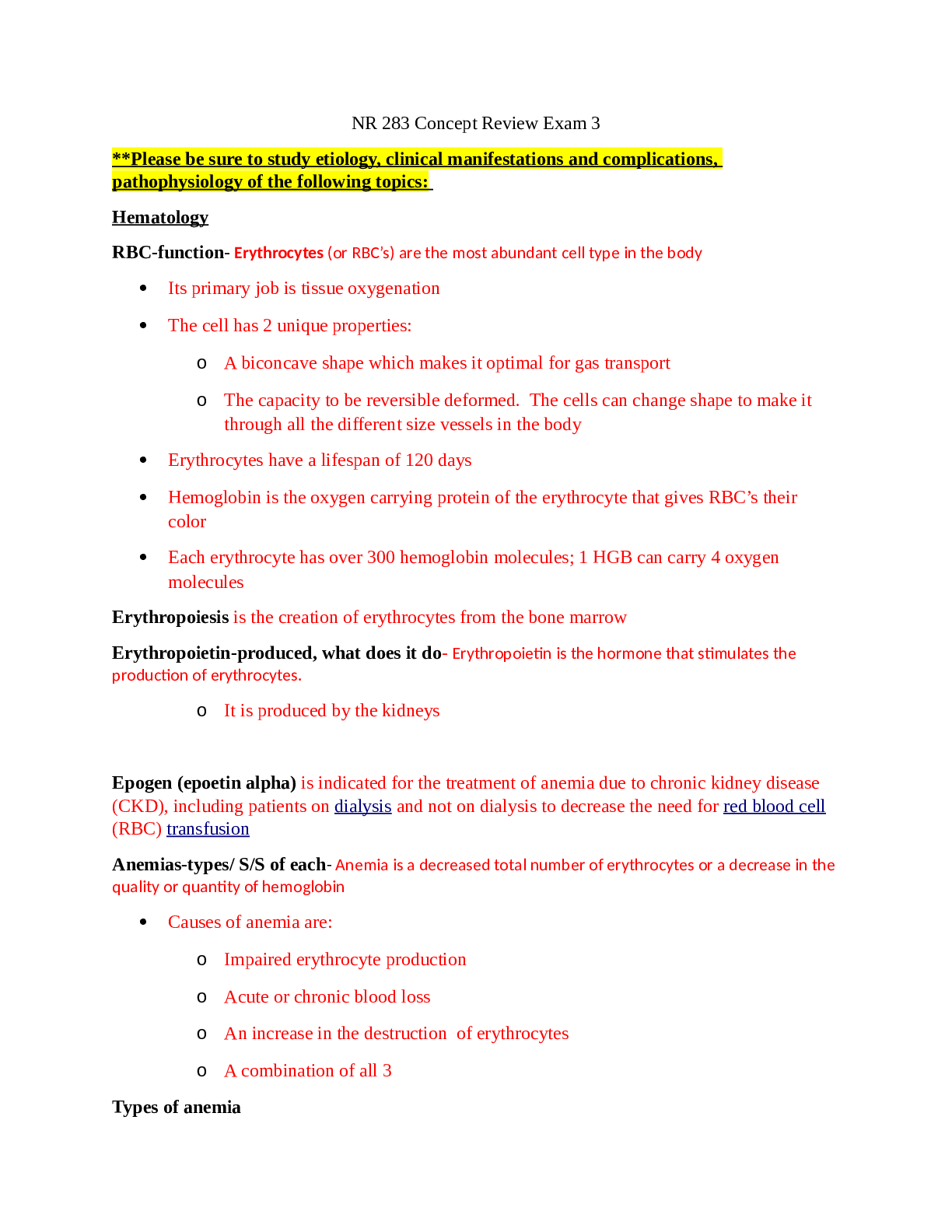
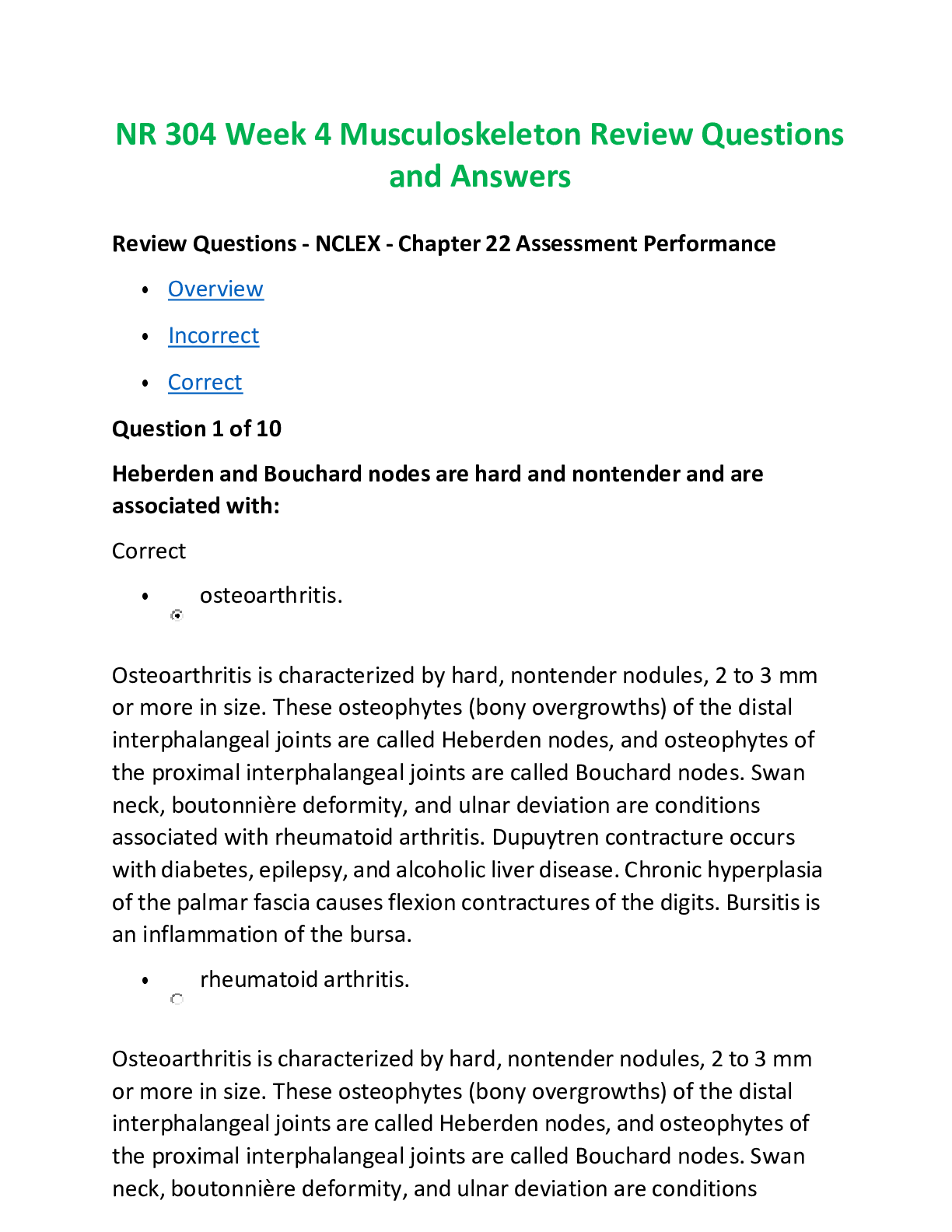

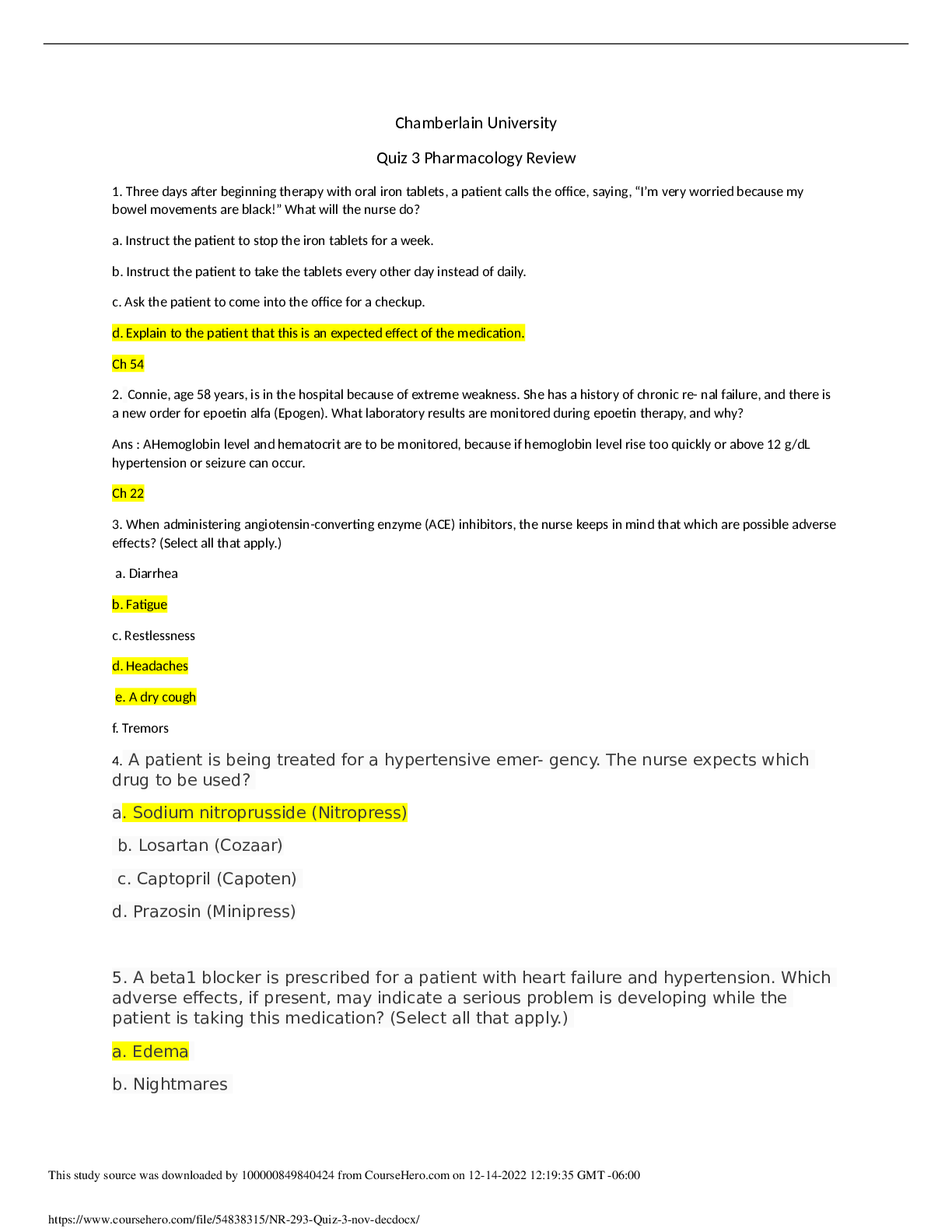

.png)
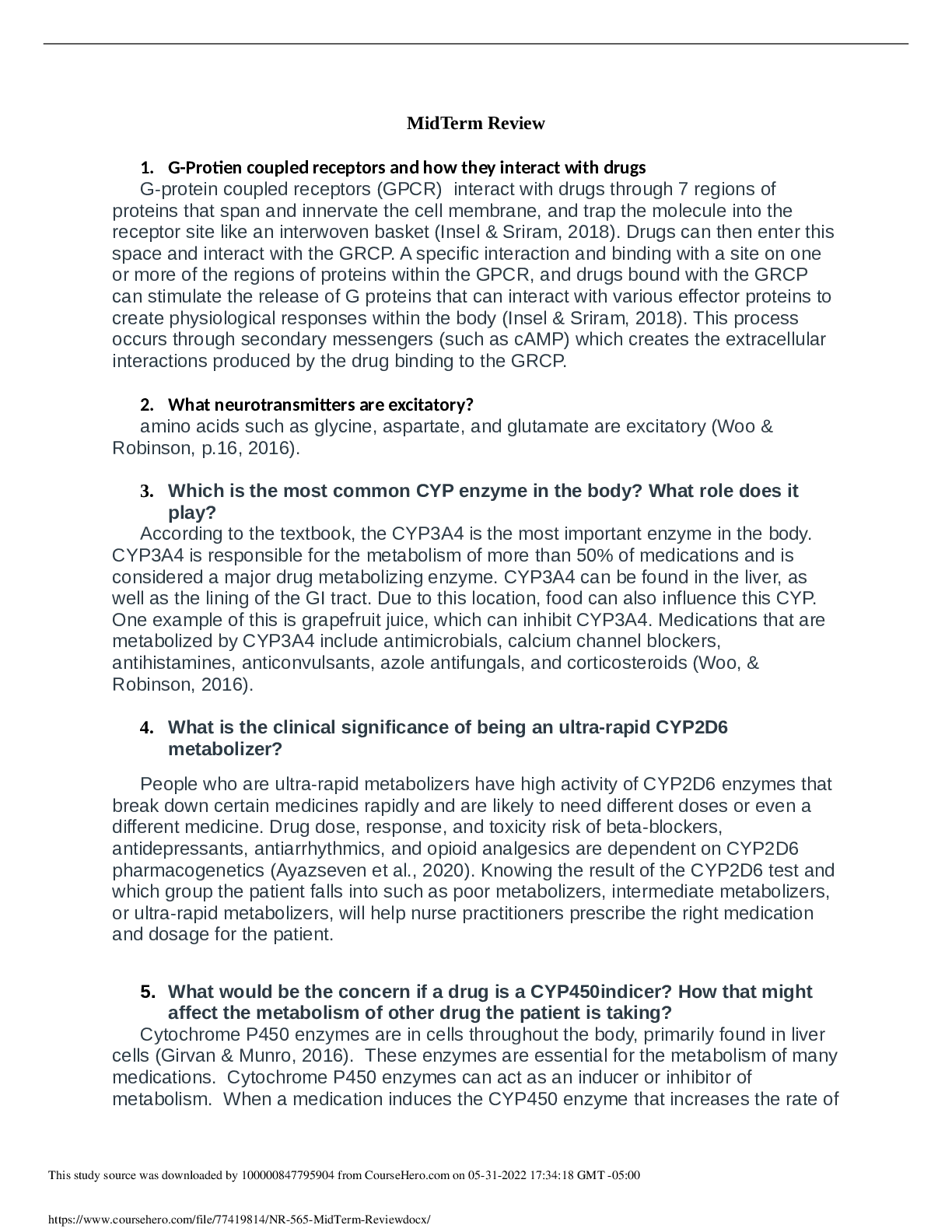
.png)
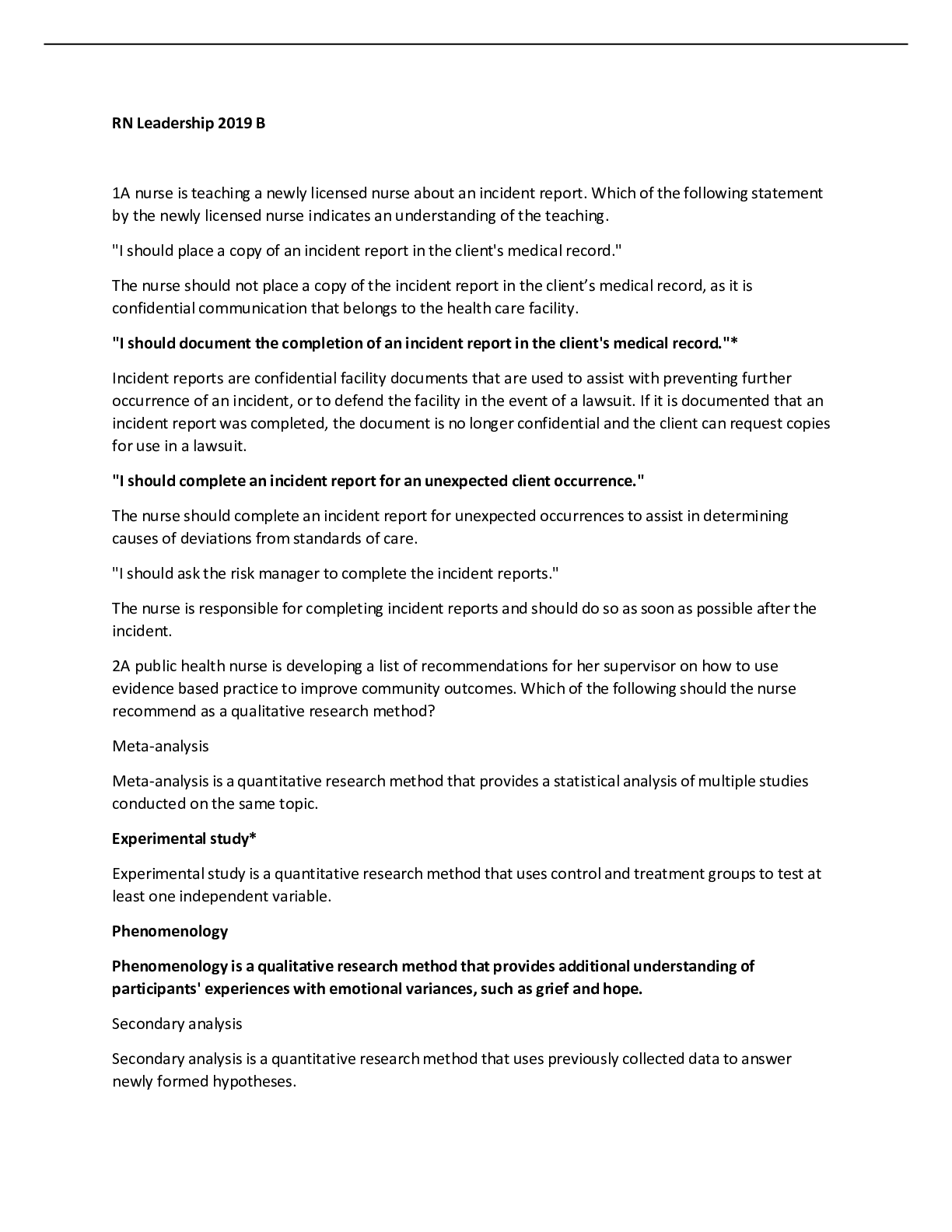

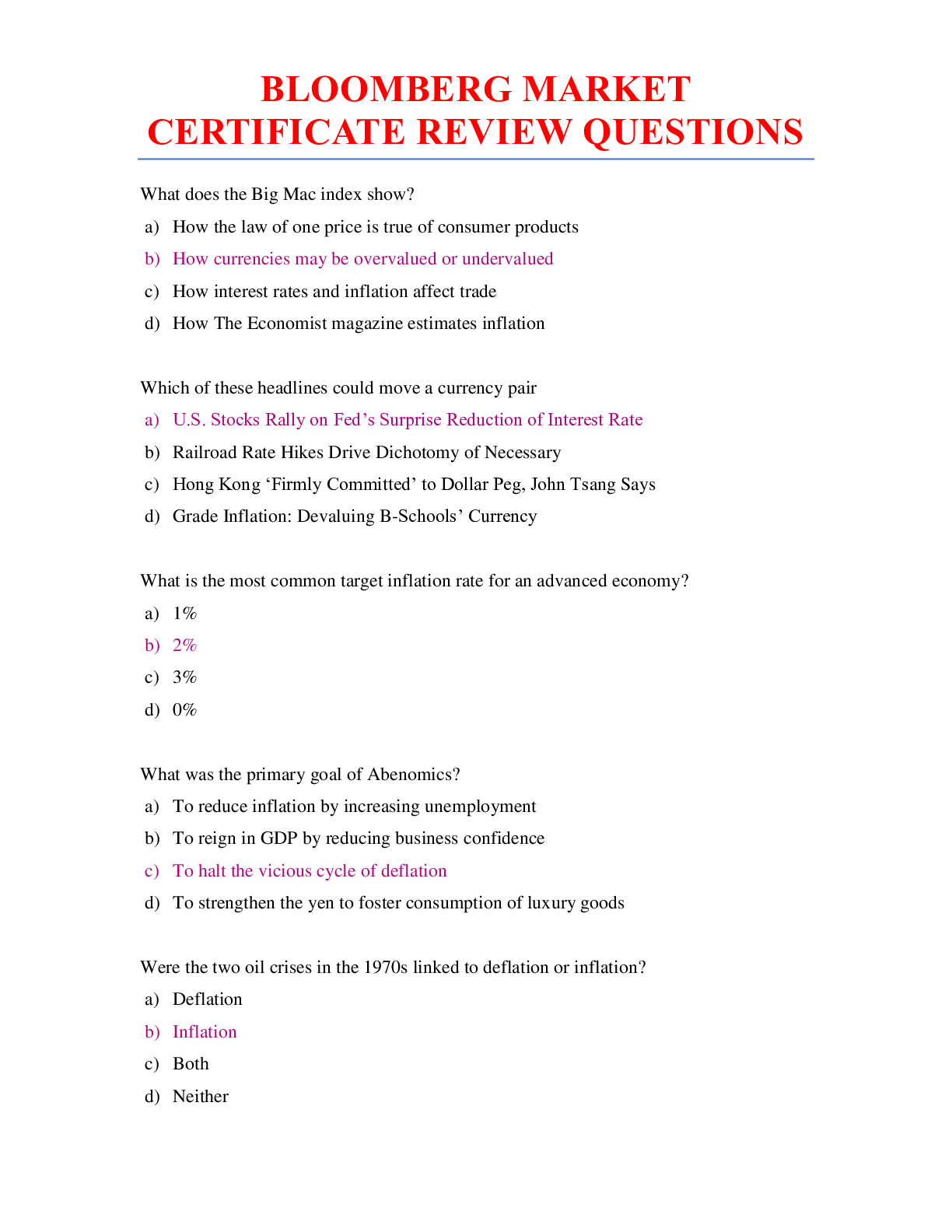
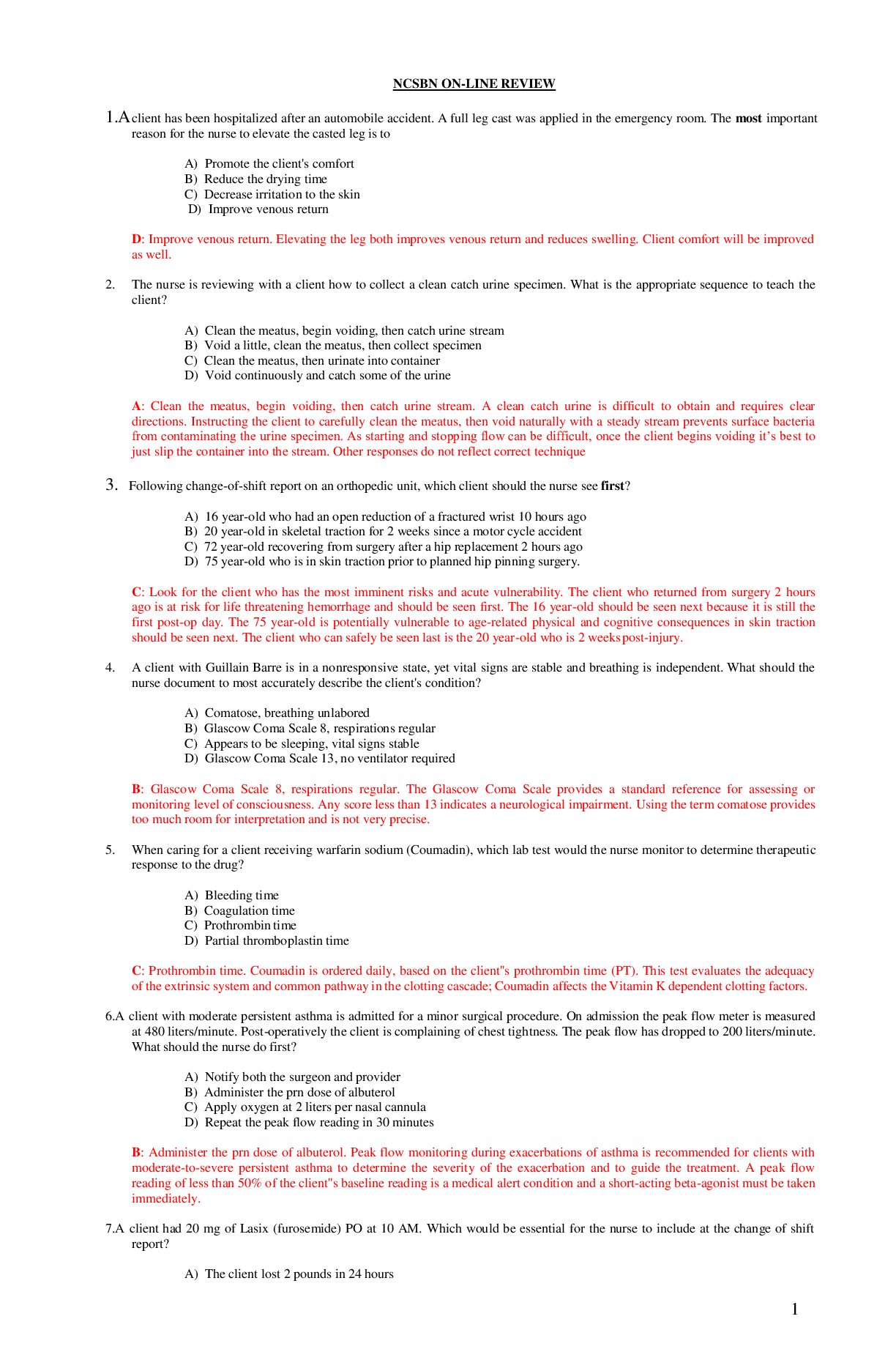



 tintin.png)
